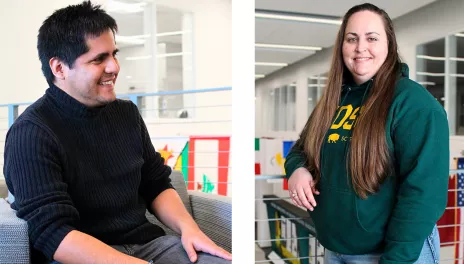NDSU’s new Peltier Complex sets the stage for emerging food scientists
Ph.D. student Diego Vargas Yana never thought about working with food when he was younger.
After completing a biotechnical engineering degree in Peru, Vargas Yana worked in a food science lab where he learned about how food impacts communities.
“We worked a lot with the rural communities in the High Andes. We were trying to get these people to rediscover their traditional crops and the value in them,” says Vargas Yana. “I grew to understand how important foods were at a cultural level, not by their nutrients.”
He says that idea is echoed by the values of NDSU, which tries to connect with the people it helps.
“I didn’t know I’d end up here, but looking back, it all makes so much sense,” says Vargas Yana. “Now I can improve the lives of people in Fargo and of my people back in Peru.”
At NDSU, he worked toward his cereal science master’s degree and became enamored with all the things he could learn.
His personal work is on dietary fiber and how it can affect the immunological system and its communication with gut bacteria.
“Science is not only about numbers and data, but about the people behind those numbers,” says Vargas Yana. “This environment pushes us toward that understanding.”
Before the Peltier Complex, most food science researchers were split between Harris Hall and the Quentin Burdick Building. Now, researchers can connect with one another in the next office over or share equipment. Vargas Yana says the spacious building is a testament to the perseverance of the students and staff.
“This has become the face of what we want to be,” says Vargas Yana. “There are people from all around the world here, and now we can get to know each other better professionally and personally.”
Kiersten Gundersen didn’t come from an agricultural background. She remembers asking her mom where meat comes from, to which she replied, “The store.”
Now a doctoral candidate at NDSU, Gundersen is the first meat science grad student to conduct research in the Peltier Complex. Her research focuses on meat safety and quality assurance with an emphasis on microbiology.
She was sold on the promise that the department would foster personal connections and that she’d have the freedom to create her opportunities through her own research.
After a three-year master’s program, she faced a decision of either continuing with a doctoral degree or pursuing a career in the meat industry.
“I kept asking what projects there are to focus on and kept receiving the same answer: You can create your own opportunities,” says Gundersen. “That’s when I realized I had to fully understand the research process to turn an idea into a cohesive project.”
Now, she’s in the last six months of her doctoral program.
Nearly all of her projects have been novel, which means she’s exploring ideas that haven’t been researched or published. As a young adult about to enter her career, being a part of innovative projects is exciting.
“This generation of students is being challenged because they need to come up with research that hasn’t been explored yet,” says Gundersen. “They need to understand the foundation of what they’re learning to take it a step further, and ask themselves ‘what do we not know?’”
Though she feels bittersweet about leaving soon, Gundersen takes pride in knowing the Peltier Complex will support future scientists.
“This building is a sign of the progress that we see,” says Gundersen. “The research that comes out of NDSU is renowned, and now we have a building that represents that and matches the industry standard. I can teach students in an environment that looks like their futures.”
